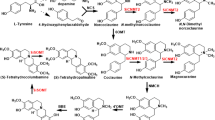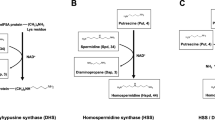Abstract
Caffeine (1,3,7-trimethylxanthine) and theobromine (3,7-dimethylxanthine) are the major purine alkaloids in plants. To investigate the diversity of N-methyltransferases involved in purine alkaloid biosynthesis, we isolated the genes homologous for caffeine synthase from theobromine-accumulating plants. The predicted amino acid sequences of N-methyltransferases in theobromine-accumulating species in Camellia were more than 80% identical to caffeine synthase in C. sinensis. However, there was a little homology among the N-methyltransferases between Camellia and Theobroma. The recombinant enzymes derived from theobromine-accumulating plants had only 3-N-methyltransferase activity. The accumulation of purine alkaloids was, therefore, dependent on the substrate specificity of N-methyltransferase determined by one amino acid residue in the central part of the protein.




Similar content being viewed by others
References
Ashihara H, Crozier A (1999) Biosynthesis and metabolism of caffeine and related purine alkaloids in plants. Adv Bot Res 30:117–205
Ashihara H, Gillies FM, Crozier A (1997) Metabolism of caffeine and related purine alkaloids in leaves of tea (Camellia sinensis L.). Plant Cell Physiol 38:413–419
Ashihara H, Kato M, Chuang-xing Y (1998) Biosynthesis and metabolism of purine alkaloids in leaves of cocoa tea (Camellia ptilophylla). J Plant Res 111:599–604
Ashihara H, Kubota H (1987) Biosynthesis of purine alkaloids in Camellia plants. Plant Cell Physiol 28:535–539
Ashihara H, Monterio AM, Gillies FM, Crozier A (1996) Biosynthesis of caffeine in leaves of coffee. Plant Physiol 111:747–753
Benton WD, Davis RW (1977) Screening λgt recombinant clones by hybridization to single plaque in situ. Science 196:180–182
Bradford MM (1976) A rapid and sensitive method for the quantitation of microgram quantities of protein utilizing the principle of protein-dye binding. Anal Biochem 72:248–254
Chang S, Puryear J, Cairney J (1993) A simple and efficient method for isolation of RNA from pine trees. Plant Mol Biol Rep 11:113–116
Choi KB, Morishige T, Shitan N, Yazaki K, Sato F (2002) Molecular cloning and characterization of coclaurine N-methyltransferase from cultured cells of Coptis japonica. J Biol Chem 277:830–835
Dudareva N, Murfitt LM, Mann CJ, Gorenstein N, Kolosova N, Kish CM, Bonham C, Wood K (2000) Developmental regulation of methyl benzoate biosynthesis and emission in snapdragon flowers. Plant Cell 12:949–961
Fujimori N, Suzuki T, Ashihara H (1991) Seasonal variations in biosynthetic capacity for the synthesis of caffeine in tea leaves. Phytochemistry 30:2245–2248
Fukami H, Asakura T, Hirano H, Abe K, Shimomura K, Yamakawa T (2002) Salicylic acid carboxyl methyltransferase induced in hairy root cultures of Atropa belladonna after treatment with exogeneously added salicylic acid. Plant Cell Physiol 43:1054–1058
Gang DR, Lavid N, Zubieta C, Chen F, Beuerle T, Lewinsohn E, Noel JP, Pichersky E (2002) Characterization of phenylpropene O-methyltransferases from sweet basil: Facile change of substrate specificity and convergent evolution within plant O-methyltransferase family. Plant Cell 14:505–519
Hammerstone JF Jr, Romanczyk LJ Jr, Aitkent WM (1994) Purine alkaloid distribution within Herrania and Theobroma. Pytochemistry 35:1237–1240
Hibi N, Higashiguchi S, Hashimoto T, Yamada Y (1994) Gene expression in tobacco low-nicotine mutants. Plant Cell 6:723–735
Joshi CP, Chiang VL (1998) Conserved sequence motifs in plant S-adenosyl-L-methionine-dependent methyltransferases. Plant Mol Biol 37:663–674
Kato M, Kanehara T, Shimizu H, Suzuki T, Gillies FM, Crozier A, Ashihara H (1996) Caffeine biosynthesis in young leaves of Camellia sinensis: in vitro studies on N-methyltransferase activity involved in the conversion of xanthosine to caffeine. Physiol Plant 98:629–636
Kato M, Mizuno K (2004) Caffeine synthase and related methyltransferases in plants. Front Biosci 9:1833–1842
Kato M, Mizuno K, Fujimura T, Iwama M, Irie M, Crozier A, Ashihara H (1999) Purification and characterization of caffeine synthase from tea leaves. Plant Physiol 120:579–586
Kato M, Mizuno K, Crozier A, Fujimura T, Ashihara H (2000) Caffeine synthase gene from tea leaves. Nature 406:956–957
Koyama Y, Tomoda Y, Kato M, Ashihara H (2003) Metabolism of purine bases, nucleosides and alkaloids in theobromine-forming Theobroma cacao leaves. Plant Physiol Biochem 41:977–984
Laemmli UK (1970) Cleavage of structural proteins during the assembly of the head of bacteriophage T-4. Nature 227:680–685
Mizuno K, Okuda A, Kato M, Yoneyama N, Tanaka H, Ashihara H, Fujimura T (2003a) Isolation of a new dual-functional caffeine synthase gene encoding an enzyme for the conversion of 7-methylxanthine to caffeine from coffee (Coffea arabica L.) FEBS Lett 534:75–81
Mizuno K, Kato M, Irino F, Yoneyama N, Fujimura T, Ashihara H (2003b) The first committed step reaction of caffeine biosynthesis: 7-methylxanthosine synthase is closely homologous to caffeine synthases in coffee (Coffea arabica L.) FEBS Lett 547:56–60
Mizuno K, Tanaka H, Kato M, Ashihara H, Fujimura T (2001) cDNA cloning of caffeine (theobromine) synthase from coffee (Coffea arabica L.,) In: International Scientific Colloquim on Coffee, ASIC, Paris, 19:815–818
Nagata T, Sakai S (1985) Purine base pattern of Camellia irrawadiensis. Phytochemistry 24:2271–2272
Naik JP (2001) Improved high-performance liquid chromatography method to determine theobromine and caffeine in cocoa and cocoa products. J Agric Food Chem 49:3579–3583
Negishi O, Ozawa T, Imagawa H (1985) Methylation of xanthosine by tea leaf extracts and caffeine biosynthesis. Agric Biol Chem 49:887–890
Negishi O, Ozawa T, Imagawa H (1988) N-methylnucleosidase from tea leaves. Agric Biol Chem 52:169–175
Negre F, Kolosova N, Knoll J, Kish CM, Dudareva N (2002) Novel S-adenosyl-L-methionine:salicylic acid carboxyl methyltransferase, an enzyme responsible for biosynthesis of methyl salicylate and methyl benzoate, is not involved in floral scent production in snapdragon flowers. Arch Biochem Biophys 406:261–270
Ogawa M, Herai Y, Koizumi N, Kusano T, Sano H (2001) 7-Methylxanthine methyltransferase of coffee plants. J Biol Chem 276:8213–8218
Ross JR, Nam KH, D′Auria JC, Pichersky E (1999) S-Adenosyl-L-methionine:Salicylic acid carboxyl methyltransferase, an enzyme involved in floral scent production and plant defense, represents a new class of plant methyltransferases. Arch Biochem Biophys 367:9–16
Sanger F, Nicklen S, Coulson AR (1977) DNA sequencing with chain-terminating inhibitors. Proc Natl Acad Sci USA 74:5463–5467
Seo HS, Song JT, Cheong JJ, Lee YH, Iwang I, Lee JS, Choi YD (2001) Jasmonic acid carboxyl methyltransferase: a key enzyme for jasmonate-regulated plant responses. Proc Natl Acad Sci USA 98:4788–4793
Suzuki T (1972) The participation of S-adenosylmethionine in the biosynthesis of caffeine in the tea plants. FEBS Lett 24:18–20
Suzuki T, Ashihara H, Waller GR (1992) Purine and purine alkaloid metabolism in Camellia and Coffea plants. Phytochemistry 31:2575–2584
Takeuchi A, Matsumoto S, Hayatsu M (1994) Chalcone synthase from Camellia sinensis: isolation of the cDNAs and the organ-specific and sugar-responsive expression of the genes. Plant Cell Physiol 35:1011–1018
Uefuji H, Ogita S, Ymaguchi Y, Koizumi N, Sano H (2003) Molecular cloning and functional characterization of three distinct N-methyltransferase involved in the caffeine biosynthetic pathway in coffee plants. Plant Physiol 132:372–380
Zubieta C, Ross JR, Koscheski P, Yang Y, Pichersky E, Noel JP (2003) Structural basis for substrate recognition in the salicylic acid carboxyl methyltransferase family. Plant Cell 15:1704–1716
Acknowledgements
We deeply thank Dr. Y. Takeda (National Institute of Plant Vegetable and Tea Science) for the generous supply of C. irrawadiensis. We also would like to thank Dr. A. Takeuchi (National Institute of Plant Vegetable and Tea Science) for providing cDNA library of C. sinensis and Mr. Y. Tomoda (Meiji Seika Kaisya Co Ltd.) for the supply of cacao trees. This work is supported by a Grant-in-Aid for Scientific Research from the Japan Society for the Promotion of Science (No.14540590 to MK., No.15780076 to KM.).
Author information
Authors and Affiliations
Corresponding author
Additional information
Communicated by R. Hagemann
Rights and permissions
About this article
Cite this article
Yoneyama, N., Morimoto, H., Ye, CX. et al. Substrate specificity of N-methyltransferase involved in purine alkaloids synthesis is dependent upon one amino acid residue of the enzyme. Mol Genet Genomics 275, 125–135 (2006). https://doi.org/10.1007/s00438-005-0070-z
Received:
Accepted:
Published:
Issue Date:
DOI: https://doi.org/10.1007/s00438-005-0070-z




